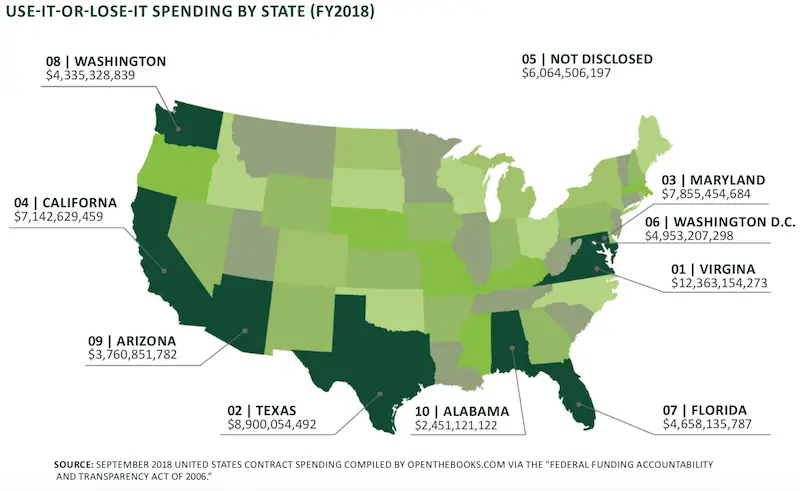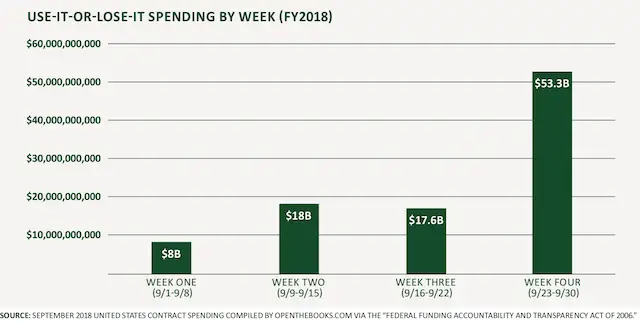A new report shows just how much federal agencies spent (or, perhaps, wasted) at the end of the last fiscal year as they rushed to use up remaining funds in their budgets.
What is the “Use it or Lose it” Concept?
Federal agencies often kick their spending into high gear in the last month of each fiscal year in an effort to use up remaining money to keep their budgets from getting cut.
“Agencies worry spending less than their budget allows might prompt Congress to appropriate less money in the next fiscal year. To avoid this, federal agencies choose to embark on an annual shopping spree rather than admit they can operate on less,” says the report.
The table from the report below shows that this phenomenon not only exists but has been on the rise in the last few years.
Use-it-or-Lose-it Spending by Fiscal Year
| Fiscal Year | Total Contracts |
|---|---|
| September 2015 | $69,621,765,648 |
| September 2016 | $73,551,447,515 |
| September 2017 | $83,683,953,487 |
| September 2018 | $96,964,204,445 |
Where Did the Money Go, and How Much was Spent?
So what did last year’s spending spree look like?
In the final month of FY 2018, federal agencies signed nearly 10% of all fiscal year contracts. It grew each week of the month too, starting at $8 billion in week one and ending up at $53.3 billion in week four. Between 2015 and 2018, federal spending during the last month of the fiscal year increased by 39%.
What was purchased?
Some of the highlights include a Wexford Leather club chair ($9,241), china tableware ($53,004), alcohol ($308,994), golf carts ($673,471), musical equipment including pianos, tubas, and trombones ($1.7 million), lobster tail and crab ($4.6 million), iPhones and iPads ($7.7 million), and workout and recreation equipment ($9.8 million). $818.1 million was spent on guns, ammo and bombs, $490.6 million on furniture and $462 million on PR and marketing.
Spending by Agency
DoD spent the most by far, coming in at just over $61 billion. The smallest spender was the Interior Department at $1.1 billion. The executive office of the president also spent $26.8 million.
| AWARDING AGENCY | TOTAL CONTRACTS |
|---|---|
| DEPARTMENT OF DEFENSE (DOD) | $61,209,301,370 |
| DEPARTMENT OF HEALTH AND HUMAN SERVICES (HHS) | $5,665,716,975 |
| DEPARTMENT OF VETERANS AFFAIRS (VA) | $5,429,028,812 |
| DEPARTMENT OF HOMELAND SECURITY (DHS) | $4,173,698,090 |
| DEPARTMENT OF STATE (DOS) | $3,988,497,959 |
| GENERAL SERVICES ADMINISTRATION (GSA) | $3,205,885,563 |
| DEPARTMENT OF ENERGY (DOE) | $2,679,322,832 |
| NATIONAL AERONAUTICS AND SPACE ADMINISTRATION (NASA) | $1,577,157,573 |
| DEPARTMENT OF JUSTICE (DOJ) | $1,378,787,388 |
| DEPARTMENT OF THE INTERIOR (DOI) | $1,158,399,343 |
Who Gets the Money?
Contractors made out quite well last September. Lockheed Martin got $8.2 billion in total contracts, Boeing $5.1 billion and Raytheon $3.3 billion.
$25.2 billion (26%) of all spending in the month went to companies in the Washington, DC area.
Other countries saw an influx of money as well. Top-receiving countries included Afghanistan ($356.3 million), India ($590.2 million), Germany ($535.6 million), Japan ($528.9 million), and Iraq ($271.4 million).
Questions Raised
The report asks several questions:
- Should there be a cap for how much the federal agencies can spend in one month?
- Should Congress reward agencies that cut their budgetsand leave excess funds unspent at the end of a fiscal year?
- What happens to excess funds that are not spent?
It doesn’t offer any answers to these, it just puts them out there for consideration based on the findings. (Feel free to address those in the comments below)
However, addressing the end of year spending by agencies is not new by any means and has been looked at by Congress before. It is something that has been spearheaded more recently by Senator Rand Paul (R-KY).
At a hearing in 2017, he said:
We have been told of the military hovering aircrafts at the end of runways just to burn off fuel, and soldiers sent to the shooting range sometimes for an entire day just to expend ammunition.
Of course I cannot forget when we took over this subcommittee, we found toner cartridges for an obsolete printer stacked to the ceiling in the subcommittee’s office space because the chairman preceding had said, “We’ve got to spend it; we have this money; we’ve got to get rid of it.” I don’t know what happened to those cartridges, but they obviously were a waste of money.
He had reintroduced legislation for the third time in conjunction with the hearing that would pay bonuses to federal employees that identify unneeded or surplus funds. It has never made it through Congress on any of the three occasions, however.
No doubt there are legitimate purchases within the massive amounts of spending detailed in the report, but it would be foolish to think there is no room for cutting back on waste as well.




